The Unspunnen Stone
The Unspunnen Stone — or Unspunnenstein — is a smooth, Swiss stone that’s thrown for distance. It’s also a significant piece of cultural heritage, symbolizing Swiss strength and tradition. The Unspunnen Stone weighs 83.5kg (184 lb) and is easily identifiable because of the 1805 1905 engraving on its face.
Thanks to a storied history spanning over 200 years filled with theft and conflict, there have been multiple Unspunnen stones.
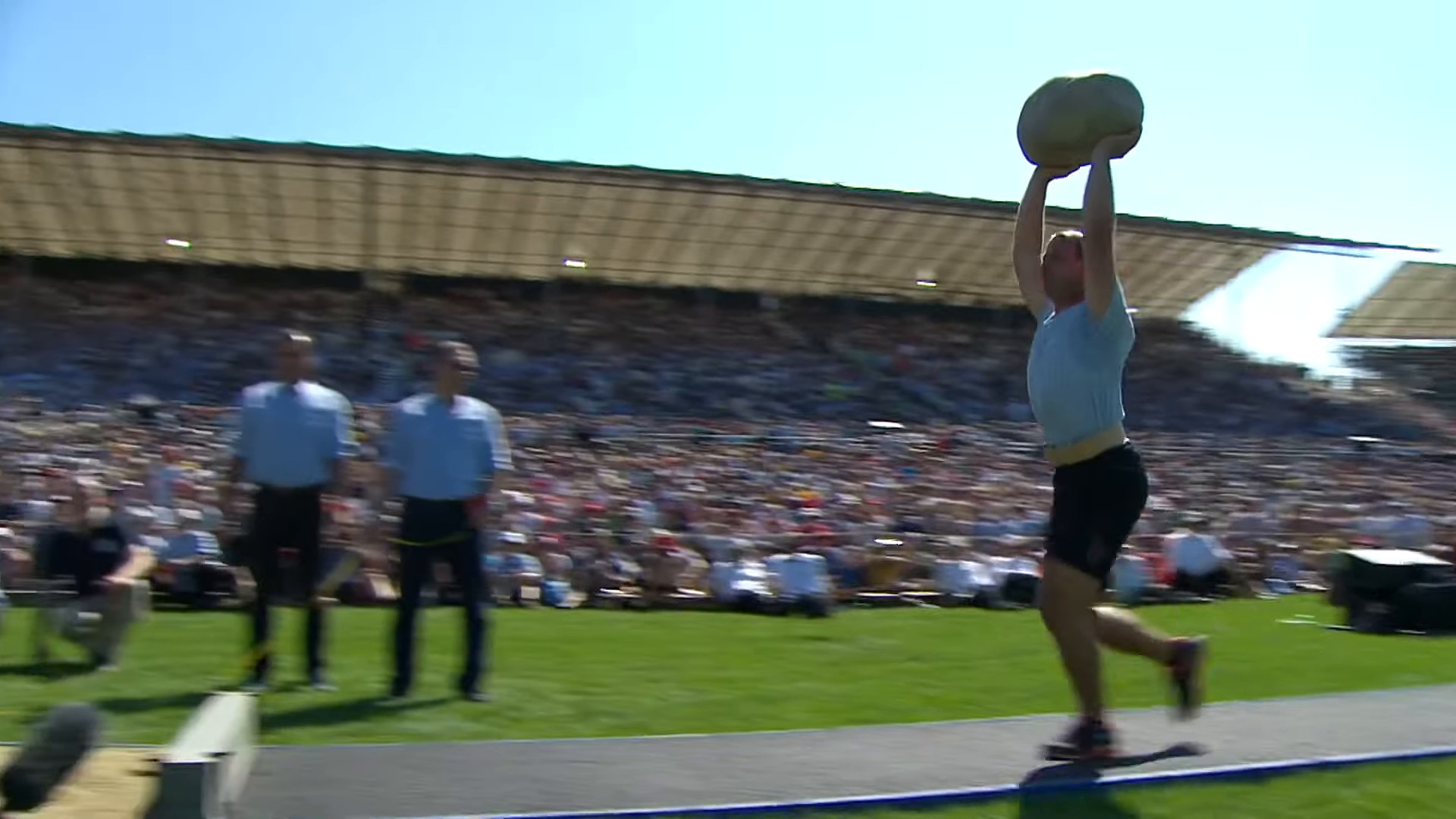
History
Origins
Stone-throwing competitions have been contested in Switzerland since at least the 13th century and likely even earlier. The size of stones thrown and the technique used to throw them varies — from lighter, one-handed stone puts, to heavy two-handed overhead tosses.1
Unspunnenfest — the Unspunnen Festival — is the stage of the most famous of all Swiss stone-throwing competitions. Unspunnenfest first took place in 1805 on the meadow in front of the Unspunnen Castle ruins. At the time, the festival was known as the Alpine Cowherders’ Festival. Tensions were high between towns following the 1803 act of mediation, so the festival was organized to ease the tension and bring people together. Among the festivities were alpine horn playing, wrestling (schwingen), and of course, the stone toss (steinstossen) using a 83.5kg (184 lb) stone.
Although the festival was successful, tensions weren’t eased quite as much as hoped.
Three years later, in 1808, the second festival took place. However, the original Unspunnen stone disappeared during the prior years, so athletes threw a different stone weighing about 83.5kg — usually referred to as the 1808 Unspunnen stone.
Although the second festival came around relatively quickly, the third wouldn’t take place for another 97 years — the festival’s centenary. So, almost 100 years after its first flight, the 1808 stone flew again. The 1805 1905 engravings on the face of the stone represent the dates of the first official festival and its centenary. Following the centenary festival, Adolf Pfahrer gifted the Unspunnen Stone to the Interlaken Gymnastic Club.2
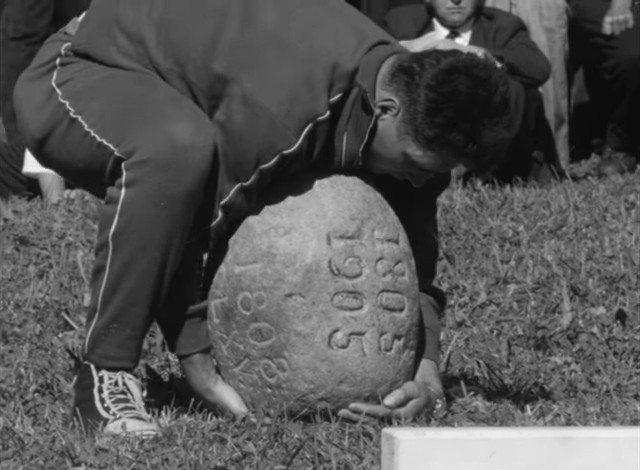
Another hiatus meant that the festival wasn’t celebrated again until 1946. The Cowherders’ Festival became known as Unspunnenfest, and would subsequently occur roughly once every 12 years: 1946, 1955, 1968, 1981, 1993, 2006, and 2017.
During the interim years between 1905 and 1946, the 1808 Unspunnen stone went missing — we don’t know precisely when, or for how long. However, when it returned, it had a hole through the centre on its underside. Some suggest it may have been used as a sharpening stone.3
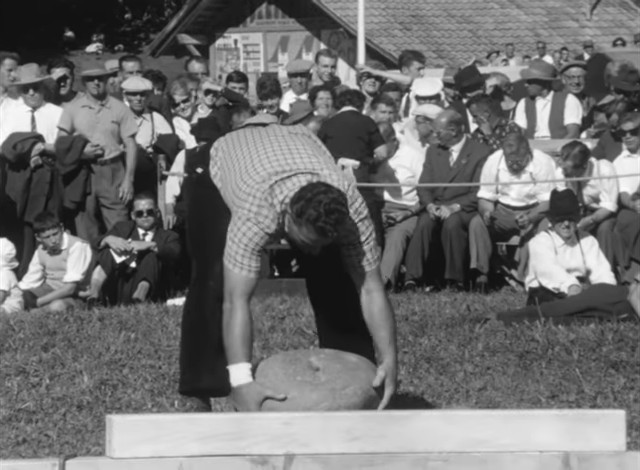
Prior to the 1968 festival, the 1808 Unspunnen stone went missing again! This time it was taken by an Interlaken postman who stashed it in his home, claiming it was his property. Of course, this was untrue since the stone belongs to the Interlaken Gymnastic Club. Eventually, the postman returned the stone just in time for the 1968 festival.3
Conflict
In 1980, the Interlaken Tourism Museum opened and displayed the 1808 stone on loan. The only time it left the exhibit was for competitions: notably the 1981 edition of Unspunnenfest. That is until 1984, when three members of the Belier Group (Jura separatists) entered the museum, successfully distracted a guard, then hoisted the stone out of a nearby window.
Some said the thieves threw the 1808 stone into the nearby lake Thun, and others rumoured that they broke it into pieces to sell off, bit by bit. The only thing we know for sure is that the stone disappeared.
With the 1808 stone missing, a new stone had to be found. Interlaken Gymnastic Club formed a committee and searched for a candidate stone — eventually finding one in a local brook near the small village of Saxeten. A local stonemason fashioned it into shape, matching the weight of the original 1805 stone.
In the late 90s, long after others had given up any hope of finding the 1808 stone, Michaël von Graffenried — a Bernese photographer following anonymous leads — captured images of a stone sitting in a wine cellar in Brussels.4
The images showed a stone that was the right size and shape and even had the correct engravings. But it was heavily vandalized: Twelve stars, the date of the Swiss national referendum, and the Jura emblem were all carved into the stone. The Belier group was unhappy that the Swiss population voted against joining the European Economic Area and retaliated by defacing a Swiss cultural treasure.
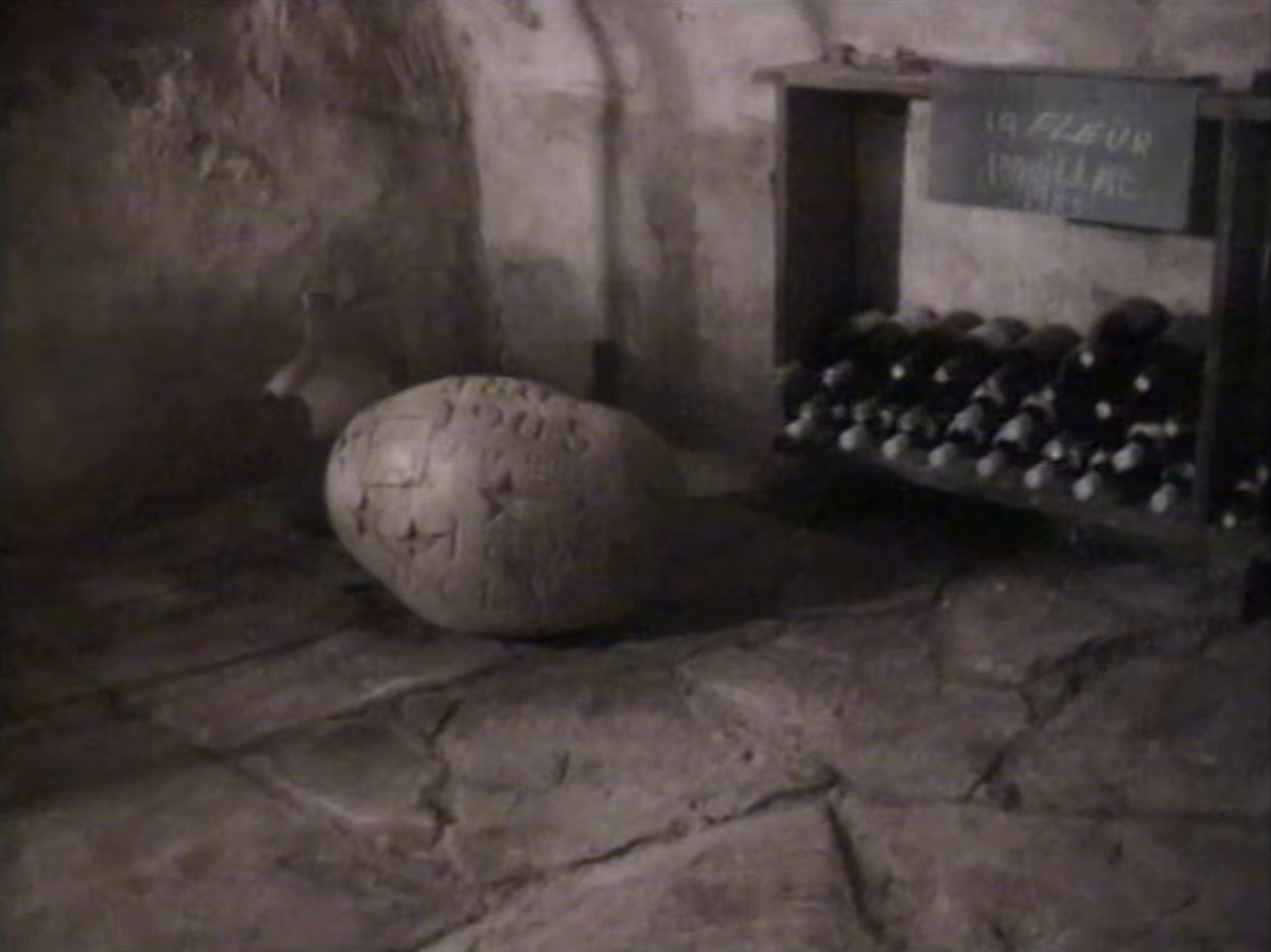
After the rediscovery and confirmation of the stone’s authenticity, the 1808 Unspunnen Stone returned home to Interlaken in 2001, 2.3kg (5 lb) lighter. Of course, the 1808 stone was now unfit for use as a throwing stone — especially since a replacement had been in use for a decade — and it became a museum piece to showcase the stone’s history.5
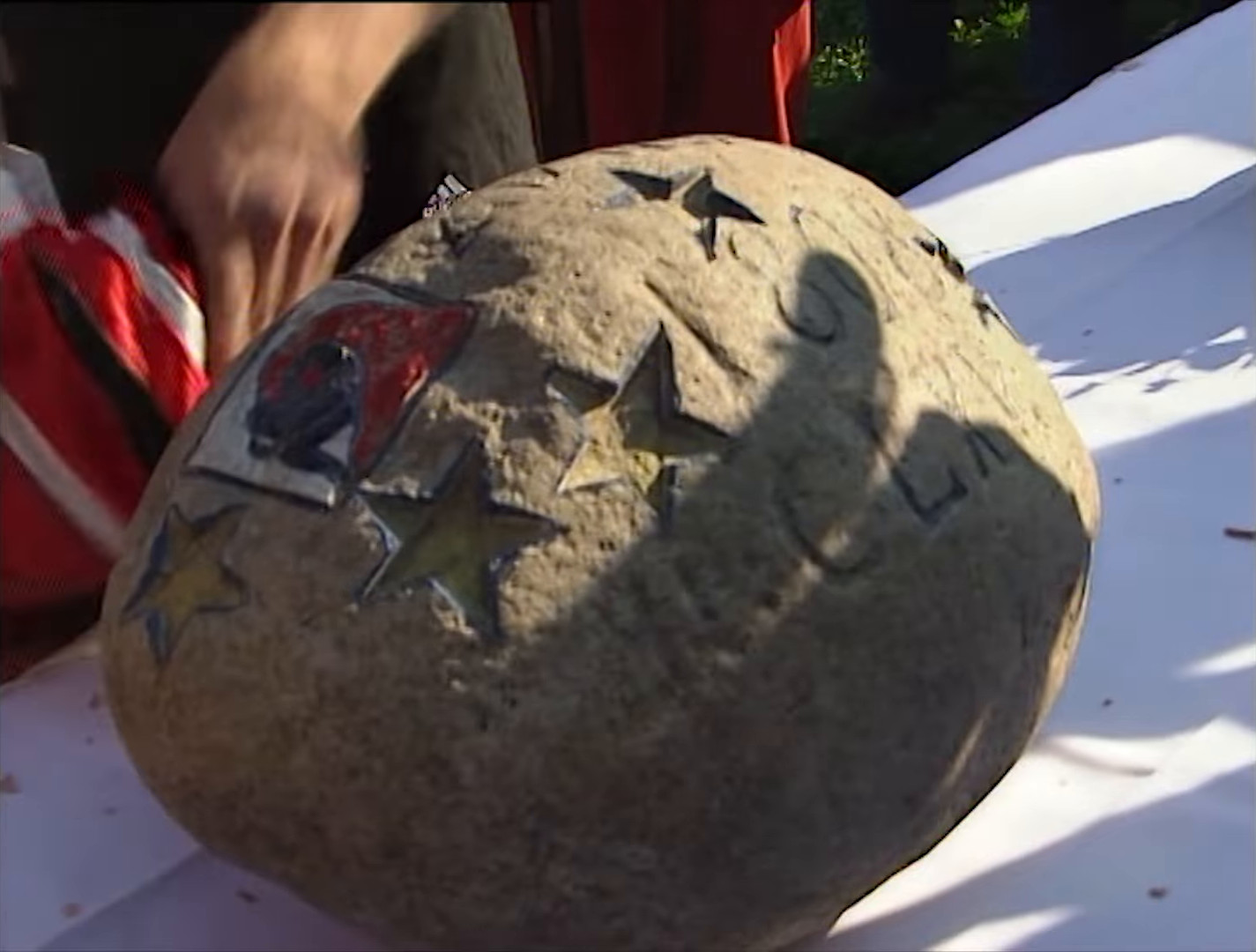
2005 brought with it the bicentenary of the Unspunnen Festival. And as part of the celebrations, the 1808 stone was placed on display at the Victoria-Jungfrau Grand Hotel & Spa: a famous luxury hotel in Interlaken.
After seven months on display, four men entered the hotel lobby pre-occupied with the stone before swiftly exiting with a sports bag. Once again, the 1808 stone disappeared. In its place, the thieves left a plaster replica of the stone painted with the Jura coat of arms. It’s thought that independent separatists were the culprits, although the Jura separatists did support the stone’s theft.6
Despite regular calls for information on the 1808 stone’s whereabouts, it’s location is still unknown, and police never identified the culprits.
In 2007, not long after Unspunnenfest 2006, the replica stone from 1985 retired from competition. After a couple of decades — and countless flights — the stone became chipped and worn, losing about 3kg (6.6 lb) in weight. It’s was displayed on a pedestal inside a bank in Interlaken. If anyone dared to move it, alarms would trip to help prevent its theft.7
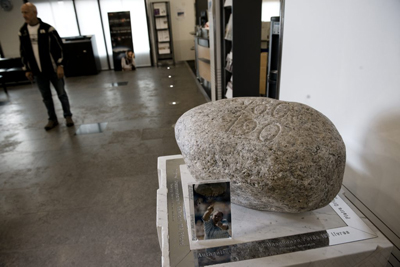
For the fourth Unspunnen Stone, a team of people from the Interlaken Gymnastics Club searched for a suitable candidate stone in the nearby mountains — just as was done back in the 80s. Once again, a stonemason shaped the stone and engraved it with 1805 1905, making sure to match the weight of its predecessors — 83.5kg.7
With the 1985 stone safely sat on a pedestal, the 2007 stone also needed somewhere safe to live between competitions. The only place safer than the bank’s pedestal is its vault, where the 2007 stone waited patiently to be collected and thrown.7
The 2007 stone was thrown until 2019. Wear on the stone caused it to retire from competition for preseveration. The 2007 stone is now stored at the bank in Interlaken. A new stone replaced it in 2022.

Unspunnen stone status
With such a long and complex history, the story of the Unspunnen stone can be difficult to follow. Here’s a list of Unspunnen stones and their current ‘status’.
- 1805 stone (92kg): Thrown in 1805, lost.
- 1808 stone (83.5kg): Stolen in 1984, discovered in 1999, returned in 2001 (weighing 76kg), stolen again in 2005, missing.
- 1985 stone (83.5kg): Thrown until 2006 - retired and now stored at the bank in Interlaken.
- 2007 stone (83.5kg): Thrown until 2019 - retired and now stored at the bank in Interlaken.
- 2022 stone (83.5kg): Current competition stone.
Competition
Unspunnenfest last took place in 2017, hosting nearly 100,000 people during the week-long celebrations. The upcoming festival is scheduled for summer 2029, meaning we’re about mid-way through the current 12-year cycle.8
The rules for throwing the Unspunnen stone in competitions have changed over the years. Here’s a typical competition format:
Athletes throw the stone at least twice to set their best distance. Then, from the farthest throws, three athletes are placed into a ‘final’ — where they get to make a third and final attempt.
The winner is the person who posts the farthest distance out of all three attempts that they made throughout the competition.
Similar to other throwing events (like the shot put), stepping over the toe-board is a foul.
Arnold Strongman Classic
On March 4th 2023, the Arnold Strongman (and Strongwoman) Classic featured an Unspunnen Stone Throw event — directly inspired by the Swiss stone.9
Rogue created two replica stones: The men’s stone weighing 83.5kg (185 lb), and the women’s stone weighing 50kg (110 lb).
Athletes were given three attempts to post their best distance.
Records
Unspunnenfest
The current distance record set at Unspunnenfest is 3.89 meters (12ft 9 inches), set by Markus Maire, in 2006.
Unspunnen
Urs Hutmacher holds the current Unspunnen distance record with 3.98 meters (13ft 1 inch) set in August 2023.
Any event
The current distance record at any event with the Unspunnen Stone is 4.16 meters (13ft 7.78 inches), set by Urs Hutmacher in August 2025.
Arnold Classic Records
Men
The men’s Rogue replica Unspunnen stone weighs 83.5kg (185 lb).
Mateusz Kieliszkowski holds the record at 11’ 4.5” (3.46m), set during the 2023 Arnold Strongman Classic.
Women
The women’s Rogue replica Unspunnen stone weighs 50kg (110 lb).
Victoria Long holds the distance record at 10’ 10” (3.3m), set during the 2023 Arnold Strongwoman Classic.
Contributions
A huge thanks to Martin Laimbacher from steinstossen.ch for his contributions to this article.
References
-
www.interlaken.ch Unspunnen Festival in Interlaken (.pdf) (Archive) ↩
-
Of Stones and Strength, 1996, pg. 56 — Of Stones and Strength contains the only reference to the stone’s disappearence in the early 20th century. It also has the only reference to the stone’s theft by the Interlaken postman. ↩ ↩2
-
www.arnoldsports.com (via archive.org) ↩
Read the liftingstones.org letters
Join thousands of other stonelifters who read the world's most popular stonelifting newsletter.